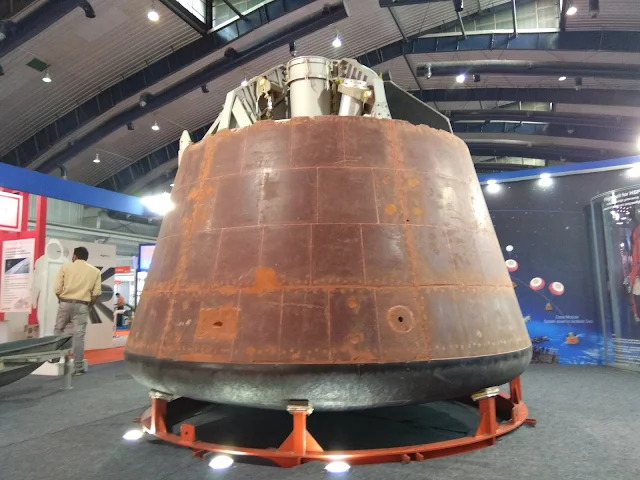
On Friday, Vikram Sarabhai Space Centre, where many Gaganyaan activities are progressing, conducted a major development test “Integrated Main Parachute Airdrop Test, or IMAT “ of its crew module deceleration system at the Babina Field Fire Range (BFFR) in the Jhansi district of Uttar Pradesh. This test marks a significant milestone toward realizing the nation's ambitious Gaganyaan project.
 |
| The crew escape module |
During the test, a 5 ton dummy weight was landed on the ground with the help of these parachutes. That is, it weighs as much as Gagnyan's crew module. IL-76 aircraft of the Indian Air Force ( Indian Air Force) were assisted for this test. The parachute was dropped from two and a half kilometers up. Two small pyro- based mortar pilot parachutes were missed during this test. After seven seconds, both main parachutes opened. This entire test was just 2 to 3 minutes.
For Gaganyaan Crew module, the Parachute system consists of a totally of 10 no. of parachutes. In flight, the parachute sequence starts with deployment of 2 Nos. of Apex cover separation parachutes (protection cover for the Crew Module Parachute compartment) followed by 2 Nos. of Drogue parachute deployment to stabilise & bring down the velocity.
Upon Drogue parachute release, 3 Nos. of Pilot chute will be used to extract 3 Nos. of Main parachute individually, to reduce the speed of the Crew module to safe levels during its landing. Two of the three main chutes are sufficient to land the astronauts on earth, and the third is redundant.
Each parachute's performance must be evaluated by complex testing methods using Rail Track Rocket Sled (RTRS) tests for smaller Parachutes and Aircraft/ Helicopters for the Main parachutes.
The Integrated Main Parachute Airdrop Test simulated the case when one Main parachute failed to open and it is the first in a series of tests planned to simulate different failure conditions of the parachute system before it is deemed qualified to be used in the first human spaceflight mission. In this test, a 5-ton dummy mass, equivalent to the Crew module mass, was taken to an altitude of 2.5 kilometres and dropped using the Indian Air force’s IL-76 aircraft. Two small pyro-based mortar-deployed pilot parachutes, then pulled the Main parachutes. The fully inflated Main parachutes reduced the payload speed to a safe landing speed as the entire sequence lasted about 2-3 minutes and the payload mass landed softly on the ground.
The design and development of the Parachute based Deceleration system for Crew module is a joint venture between Indian Space Research Organisation (ISRO) and the Defence Research and Development Organization (DRDO) and with this test, a significant milestone toward realizing the nation's ambitious Gaganyaan project is achieved with the active coordination between the country’s premier agencies, namely ISRO, DRDO, the Indian air force, and the Indian Army.
















 IndianWeb2.com is an independent digital media platform for business, entrepreneurship, science, technology, startups, gadgets and climate change news & reviews.
IndianWeb2.com is an independent digital media platform for business, entrepreneurship, science, technology, startups, gadgets and climate change news & reviews.



